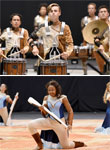|
|
Spotlight
The Marching.com Spotlight presents news and articles on topics related to marching bands and pageantry arts.
Share this page: View more articles Suggest an article topic
Popular articles
Seen and Heard at BOA 2017 2017 Winter Circuit Championship Schedule Prep your body for marching season 2015/2016 Bowl game parade and holiday parade schedule 12 Holiday Gift Ideas for Marching Band Fans Seen and Heard at BOA 2015 Double Thumbs Up for the Mighty Cavalcade of Bands Honor Band Inaugural Parade Marching Band Invitations Pride of the Dutchmen Marching Band German bugle band makes its mark at Calgary Stampede Marching bands to honor 9/11 anniversary Traveling Efficiently Specialized Marching Band Carts 2012 Macy's Thanksgiving Day Parade Band Selections Don't You Judge Me The Sound of Perfection Movie Working With a Travel Agent Fiesta Bowl Memorable for Norton Band Nerds vs. Geeks 'Band Nerds' Holiday Poem Drum beat sparks music passion Sport, Art, or...Spart? Musical Growth Spurt First Day of Rehearsal Troopers Drum Corps Documentary Ripped Jeans And Self-Esteem Boot Camp For Bands Gimme Some Props Benefits of Indoor Percussion Secrets of a Successful Audition A Disappearing Act An Alternate Universe One More Time Around Again Marching Band Steamboat Springs Ski Band Band Boosters Support Dreams Ohio State School for the Blind Marching Band Rose Parade Float Honors Marching Bands Throw It Down Movie Bob McGrath inspires on Sesame Street Rose Parade Float Decorators Bugles Across America High School Musical Choreographer Bonnie Story Working in Harmony at Fillmore Central H.S., Harmony, Minnesota Marching Amidst the Glaciers at Colony H.S., Alaska Empowering Multiplicity at Trenton Peabody H.S., Tennessee Visualizing the Extraordinary at Sebring H.S., Florida Henson blends winter guard with puppetry in Panther & Crane Competition: How important is it? Band Nerds Poetry Book XtremeBrass Technique helps brass players Capturing Show Design Ideas Halftime Magazine Debuts From The 50 Yard Line Movie Three Tips for Cleaning Drill American Band Book YouTube Marching Videos Brentwood Band plays on Brad Paisley CD Macy's Marching Band Broken Arrow Documentary Online Fundraising Color Guard Flag Design Marching Band Health Tips European Flower Parades |
Tips to keep marching bands healthy and hydratedTimely Recommendations to Ensure Band Members are Well Prepared for Activity DALLAS, August 7, 2006 — With the beat of a drum, the blow of a whistle, and the blare of the brass section, marching bands across the country are practicing formations and new musical routines in anticipation of the start of the school year. Recognizing the unique needs of these performers, the National Athletic Trainers' Association (NATA) has issued timely guidelines to ensure safety on the field and in the parade line.  "Marching band members, just like athletes, need to be well conditioned and prepared for the rigors of band practices and performances. These unique athletes are often in formations for long periods of time, wearing heavy clothing in warm weather conditions, and carrying instruments that require dexterity and strength," said Brian Robinson, MS, ATC, chair of NATA's Secondary School Athletic Trainers' Committee. "It's critical for band directors to work closely with school athletic trainers and medical professionals to develop a safety protocol to ensure band members march on the field fit to perform at their best." "Marching band members, just like athletes, need to be well conditioned and prepared for the rigors of band practices and performances. These unique athletes are often in formations for long periods of time, wearing heavy clothing in warm weather conditions, and carrying instruments that require dexterity and strength," said Brian Robinson, MS, ATC, chair of NATA's Secondary School Athletic Trainers' Committee. "It's critical for band directors to work closely with school athletic trainers and medical professionals to develop a safety protocol to ensure band members march on the field fit to perform at their best."
NATA recommends the following tips for parents, band directors, medical professionals and marching band members:
For more information on youth sports and sports safety, please visit http://www.nata.org/youthsports/. About the National Athletic Trainers' Association (NATA): Athletic trainers (ATCs) are unique health care providers who specialize in the prevention, assessment, treatment and rehabilitation of injuries and illnesses. The National Athletic Trainers' Association represents and supports 30,000 members of the athletic training profession through education and research. Copyright 2006 Marching.com. All rights reserved. This material may not be published or redistributed without permission. Recent Headlines: 2018 Tournament of Roses Bandfest Photos | Prep Your Body for Marching Season | Marching Band Music Arrangers | Marching.com on Facebook | Marching.com on Twitter | Marching.com on Pinterest |
|
 Hydrate, Hydrate, Hydrate: Establish a hydration plan that allows band members to drink water or sports drinks such as Gatorade throughout practice sessions (about 7-10 ounces every 10-20 minutes). It is important to hydrate before AND after routines. Without proper hydration, they are at risk of developing exertional heat related illnesses. Make sure that band members have sports drinks and water should always be available. Don't assume they can share with sports teams.
Hydrate, Hydrate, Hydrate: Establish a hydration plan that allows band members to drink water or sports drinks such as Gatorade throughout practice sessions (about 7-10 ounces every 10-20 minutes). It is important to hydrate before AND after routines. Without proper hydration, they are at risk of developing exertional heat related illnesses. Make sure that band members have sports drinks and water should always be available. Don't assume they can share with sports teams.